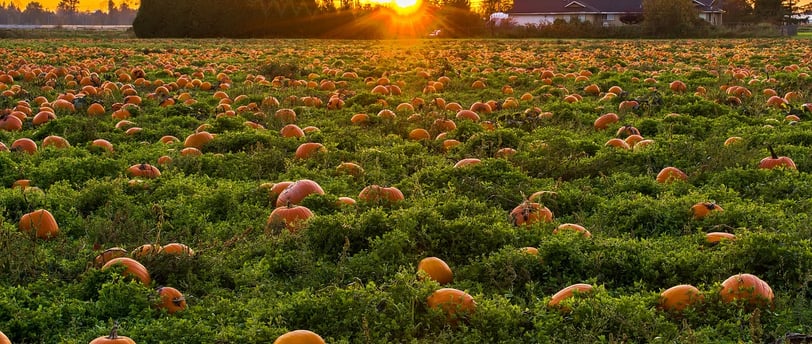Exploring the Fascinating World of Pumpkins
Brief History of Pumpkins
10/28/20243 min read


When you think of pumpkins, you might envision a classic Halloween jack-o’-lantern, or a pie made from rich orange flesh. But pumpkins are more than just festive symbols—they come in a delightful array of sizes and shapes, and their cultivation is a vibrant part of American agriculture. Let’s dive into the fascinating world of pumpkins, exploring their size diversity and the key regions in the U.S. where they thrive.
A Range of Sizes and Shapes
One of the most remarkable things about pumpkins is their incredible variety in size and shape. This diversity is not just for show; different sizes serve different purposes, from decoration to consumption.
Mini Pumpkins:
Size: Typically, about 3 to 6 inches in diameter.
Use: Ideal for decorative purposes and as table Centerpiece.
Standard Pumpkins:
Size: Usually, 8 to 12 inches in diameter.
Use: These are the classic pumpkins you see at Halloween and for cooking. They’re perfect for carving and for making pies and soups.
Giant Pumpkins:
Size: Can exceed 1,000 pounds and sometimes reach up to 2,000 pounds or more.
Use: Primarily grown for competitions and festivals. They’re often showcased in agricultural fairs and pumpkin festivals.
Specialty Pumpkins:
Size: Varies widely, including varieties like the Cinderella pumpkin, which is flatter and more ribbed, or the heirloom varieties that can have unique shapes and colors.
Use: Often used for their unique appearance in decorative displays or gourmet cooking.
Where Pumpkins Grow Best in the U.S.
Pumpkins are an American crop, with their growth thriving in specific regions of the United States. Here’s a look at where pumpkins flourish and why these areas are ideal for their cultivation:
Illinois:
Notable for Leading the nation in pumpkin production. Illinois is known for its large-scale pumpkin farms, especially in the central and northern regions of the state.
Why: The state’s rich, loamy soil and favorable climate conditions make it perfect for growing pumpkins. The annual “Pumpkin Capital” festival in Morton, Illinois, celebrates this bountiful crop.
Ohio:
Notable for: A significant pumpkin producer, with many farms specializing in both decorative and culinary varieties.
Why: Ohio’s moderate climate and fertile soil are ideal for growing pumpkins, with a growing season that supports healthy plant development.
Pennsylvania:
Notable for: Producing a variety of pumpkins, from traditional orange to specialty types.
Why: The state’s diverse soil types and growing conditions are well-suited to pumpkin cultivation, making it a key player in the pumpkin industry.
California:
Notable for: Its diverse agricultural output, including pumpkins, particularly in the central and northern parts of the state.
Why: California’s long growing season and varied climate allow for a wide range of pumpkin varieties to flourish.
New York:
Notable for: A significant producer of pumpkins, especially in the Hudson Valley and Long Island regions.
Why: New York’s cool temperatures and rich soil contribute to robust pumpkin growth, with farms producing pumpkins for both local consumption and broader markets.
Michigan:
Notable for: Growing a range of pumpkin varieties, including those for both decoration and consumption.
Why: The state’s climate and soil conditions are conducive to pumpkin farming, particularly in the southern regions where the growing season is longest.
Growing Tips for Home Gardeners
If you’re inspired to grow pumpkins in your own garden, here are a few tips to get you started:
Sunlight: Pumpkins need full sun for at least 6-8 hours a day.
Soil: Well-draining soil rich in organic matter is crucial for healthy pumpkin growth.
Watering: Consistent moisture is important, especially during the fruit-setting stage.
Space: Pumpkins require ample space to spread out, so make sure to provide plenty of room for the vines.
Bottom Line
Pumpkins are a versatile and fascinating crop with a wide range of sizes and uses. From mini pumpkins perfect for decor to giant pumpkins showcased at fairs, their diversity is truly impressive. In the United States, pumpkin-growing regions such as Illinois, Ohio, Pennsylvania, California, New York, and Michigan lead the way, thanks to their ideal climate and soil conditions. Whether you’re buying pumpkins for carving, cooking, or just for fun, understanding their growth regions and varieties can enrich your appreciation of this iconic Autumn vegetable.
When it comes to home interior design, creating a cohesive and inviting atmosphere is essential for every room in your house. From the living room to the kitchen, thoughtful decor can transform your space into a sanctuary. Explore our tips, inspirations, curated products, and more that will help you during your home interior journey.
info.hsentials@gmail.com
H'Sentials - Home Interior Designs © 2024. All rights reserved.
